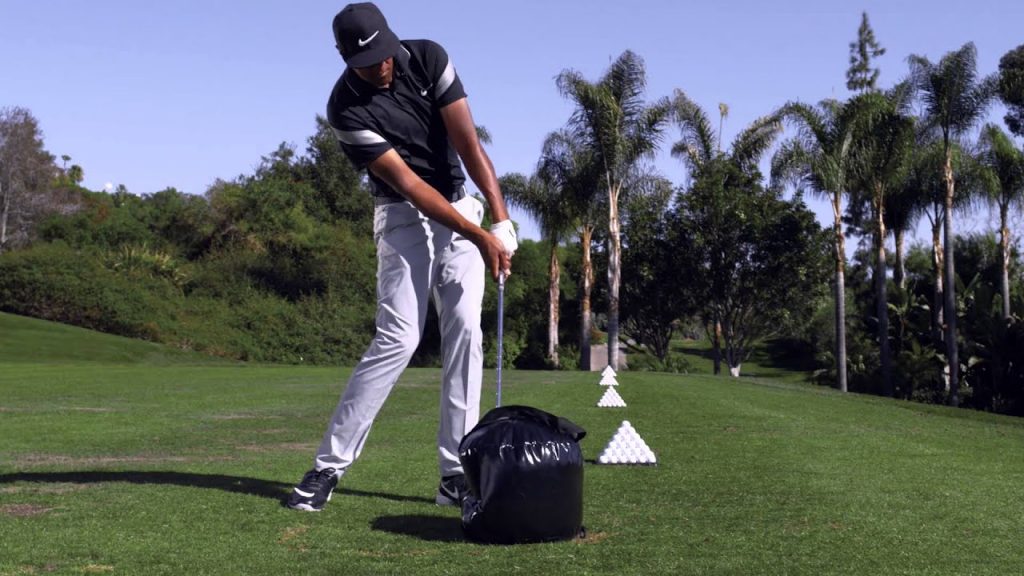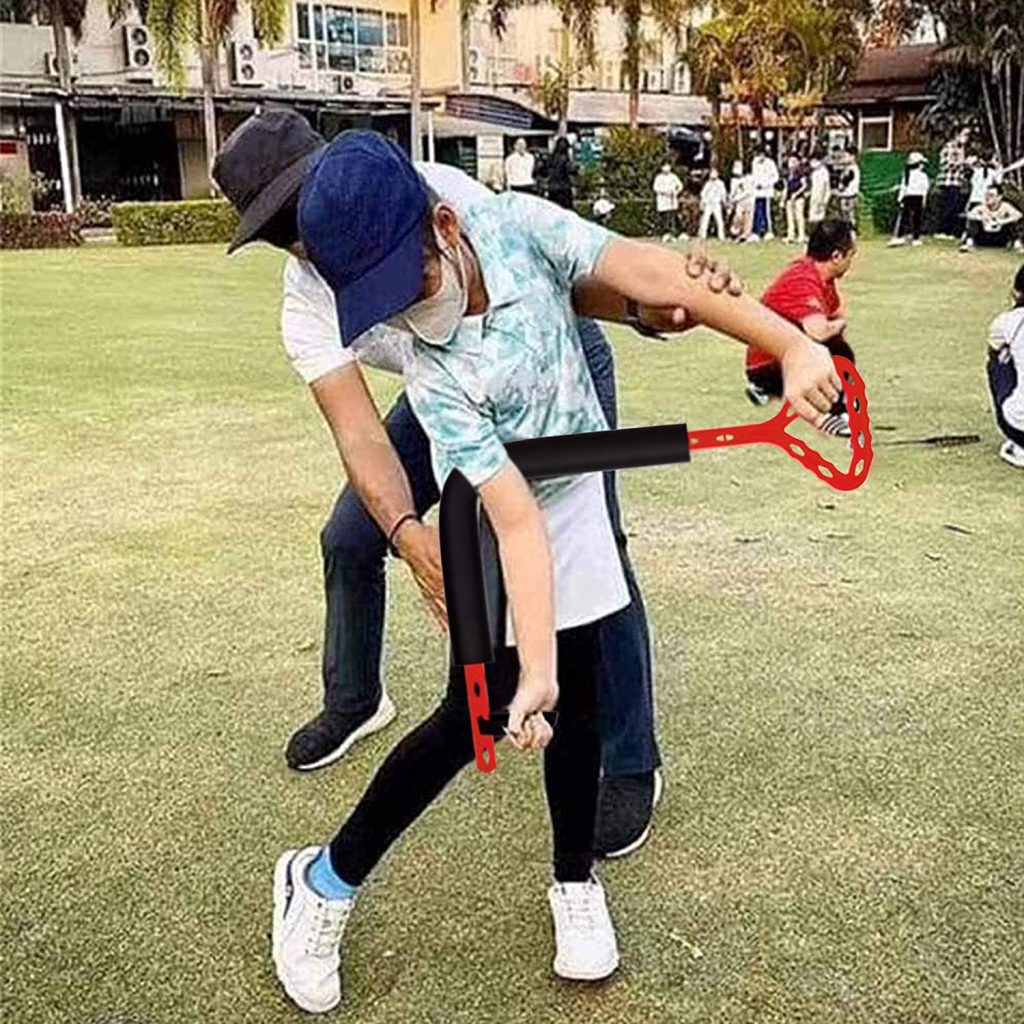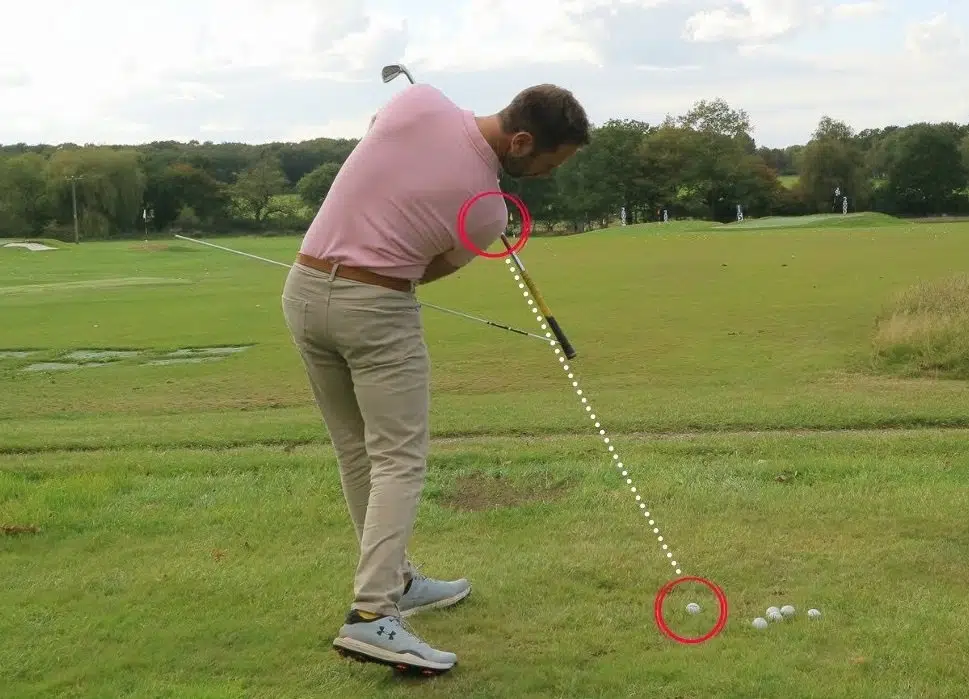One of the most common, but misunderstood, terms in golf is ‘covering the golf ball’.
The first time I heard it, I had no idea what it meant – all I knew is that the phrase kept popping up time and time again during the many, many instructional YouTube videos I watched on improving my ball-striking.
According to the top golf teachers online – from Rick Shiels, to Mark Crossfield to George Gankas – in order to create better compression with my swing, especially when using irons and wedges, I needed to learn how to cover the golf ball.
So, how do you do it?
To cover the golf ball, you should feel like you squat into the ground as you begin the downswing, with your chest also working down towards the ball. Through impact, your hips should open, and the palm of your trail hand remain pointed flat over the ball, with the club shaft leaned forward.
If you’re reading this article then, just as I did, you’ve been trawling the internet searching for an explanation about what this popular, but often confusing, piece of swing advice really means – and how to implement it.
So, before I give you some tips and drills that I’ve used myself to learn how to cover the golf ball better (with great results), first let me define the term.
Table of contents
What is covering the golf ball?
Covering the golf ball is when a player maintains their spine angle throughout the golf swing by feeling like their chest is working down towards the ball during the downswing. This prevents early extension of the hips and torso, and creates the correct amount of forward shaft lean at impact that produces better compression of the golf ball.
Now, if you’re new to the game, you’re probably thinking: Shaft lean? Spine angle? Compression? Early extension? What on earth does all that mean? Trust me, I felt the same way the first time I heard this golf jargon.
To make the rest of this article easier to follow, below are some simple definitions for each of the terms.
What is forward shaft lean?
Forward shaft lean is essential for good ball striking, and is created by having your hands slightly ahead of the ball at impact (hence, leaning the club shaft forward). It is created when you correctly shift your weight into your lead side during the downswing and clear your hips, resulting in better compression of the golf ball.
A great way to replicate the feeling of correct shaft lean is with a golf impact bag, as I’ve explained in another article.
They’re an affordable and extremely effective training aid that can help provide instant feedback and fast results.

What is compression?
Compression is created when your clubhead strikes the golf ball, sandwiching it against the turf and generating the force required to propel it into the air. Ideal compression happens when there is the right amount of forward shaft lean (typically up to 30 per cent delofting of the club face for Tour players) at impact.
What is spine angle?
Spine angle is simply as it sounds: the angle your spine creates when you address the golf ball. Maintaining this angle throughout the golf swing, rather than losing your posture by early extending as you strike the ball, results in better compression and consistency.
What is early extension?
Early extension is the action of losing your spine angle as you arrive at impact. It often involves the hips moving towards the ball during the downswing, rather than rotating out of the way. Early extension can cause inconsistent strikes and flipping of the hands at impact, which will create less compression.
Key tips: How to cover the golf ball
Now that you know what covering the golf ball is – and the resulting reactions that occur when you do it correctly – it’s time to learn how to do it.
And don’t worry, it’s actually quite easy. But you’ll be surprised just how much it will improve your ball-striking, and lower your scores in no time.
Here’s how to cover the golf ball: step-by-step.
1. It starts with the legs
Once you have made a full turn and arrived at the top of your backswing, this is where the magic happens – and what you do next is key to covering the golf ball correctly.
As you begin your downswing, you should feel as though your legs begin to squat – similar to if you were preparing to jump vertically into the air.
Squatting at the beginning of your downswing does two important things: firstly, it helps you maintain your spine angle as you continue through to impact, and secondly it allows your hips to move away from the golf ball to create more room for you arms to swing freely through the hitting area.
2. Keep your chest over the ball
As you progress through your downswing, you should feel as though your chest works down towards the golf ball.
Of course, it won’t actually get closer to the ball, but the feeling will help you maintain your spine angle, which – as I explained earlier – is pivotal to creating consistency, and better compression, in your ball-striking.
One of the biggest flaws many mid-to-high handicappers have in their swing is losing their posture, and working on keeping their chest moving down as they arrive at impact will prevent this from happening.
A device that may help you groove this feeling is the Hadgethey Golf Swing Training Aid (pictured below), which will train your body to maintain its posture through the entire swing and keep your chest over the ball (while maintaining a bent elbow, and stable clubface, at impact).

3. Feel your hips open to the left
As you squat and keep your chest down, you should also feel your hips open left, away from the ball.
To amateur players who early extend (stand up as they arrive at impact) this will feel unnatural at first, but is a key element to good ball-striking.
Letting your hips work away from the golf ball, rather than thrusting towards it, leaves you in a better position to rotate and creates the space needed for your arms and hands to swing freely through impact.
4. Keep your palm down
Just before you strike the ball, you should feel like your right palm is pushing down towards the ground (almost is if you’re preparing to bounce a basketball) – for lefties, this would be your left hand.
Feeling this motion with the palm of your hand will promote forward shaft lean at impact, which in turn will improve your compression.
The Anti-Flip Wrist Band is a perfect, low-cost training aid that can help ensure your right palm is covering the ball correctly.
5. Explode through impact
If you’ve done the above four steps correctly, by the time your club has reached the ball you should have remained in your posture/spine angle that you made at address, with your hands nicely covering the ball.
As you strike the ball, feel as though your legs straighten and explode upwards as your hip continues to clear out of the way.
This will produce effortless power and push you into the perfect finishing position.
The video below from Top Speed Golf is the best visual guide on how to cover the ball I’ve been able to find online:
What happens if I don’t cover the golf ball?
While those four steps seem easy enough to follow, learning to cover the ball properly in your golf swing can take lots of practice – that was certainly the case for me.
It can be frustrating training your body to move in a different way, but trust me it is the best thing you can do to improve your ball-striking.
Arguably the most common swing fault in amateur players is early extension, and it is a direct result of players failing to cover the ball properly.
Without focusing on keeping their chest moving down towards the ball and hips moving back, most mid-to-high handicappers will instead thrust their hips towards the ball as they start their downswing, causing them to stand up out of their posture.
This will see players lose lag, speed and forward shaft lean – meaning the ball will tend to balloon into the air more – and lastly make it difficult to control the low-point of their swing, leading to inconsistent strikes (either fat or thin).
Learn to cover the ball correctly, and you’ll eliminate these faults from your game in no time.
Best drills for covering the golf ball better
Now that you know what covering the golf ball should feel like, it’s time to groove it at the practice range so that it becomes second-nature.
After all, perfect practice makes perfect.
As someone who constantly has to work on covering the ball (I’m a chronic early extender when I’m feeling rusty, or am swinging poorly), I’ve tried many, many drills in order to stamp the right feelings into my subconscious so that I can produce the right moves on the course.
Here’s the two I’ve found work best.
Butt back alignment stick drill
As someone who is constantly fighting early extension, this drill from Zach Allen Golf is without doubt my favourite – and has helped me make big improvements in my swing.
It’s really easy to do, and gives you immediate feedback which will help you improve faster when done correctly.
You will need an alignment stick for this drill. Here’s how it works:
- Push your alignment stick into the ground nice and firm
- Take your set-up position so that your butt is touching the alignment stick
- Slowly take your backswing, feeling that your butt remains in contact with the alignment stick
- Take a short pause at the top
- Start your backswing, begin to squat and push your butt back into the alignment stick (you should feel it bend)
- Ensure your butt never breaks contact with the alignment stick as you take an abbreviated swing
The key to this drill is doing it slowly, and methodically – time and time and again.
Exaggerating a movement at slower speed has been proven to get results faster than trying it at full speed.
After every 10 or so drill swings, you can then try taking a fuller swing and replicate the feeling of your butt staying back – just as you’ve practiced.
Doing this drill over and over, every week, will soon eliminate your early extension for good – and have you covering and compressing the ball like a pro.
You can watch the drill in the video below:
If you want to read more about how you can incorporate alignment sticks into your practice, I’d definitely recommend you read our detailed guide.
We explain why they’re an essential training item, and list some great drills that incorporate them.
Grip down and hover drill
This next drill from TruGolf Academy is a great one if you’re a player who struggles to maintain your spine angle through the golf swing.
As mentioned earlier, staying in your posture is essential to covering the golf ball and creating consistent, quality compression.
It’s really simple. Here’s what you need to do:
- Set up to the golf ball with a mid-iron
- Grip the club around three inches down the handle
- Rather than moving closer to the ball to compensate, stay where you normally would at address (the club will hover above the ball)
- Make a normal backswing, and on the downswing feel like your chest moves down towards the golf ball (similar to taking a bow)
- With these feelings in mind, make an abbreviated three-quarter swing
What this drill should do is make you feel more bend at the waist and as though you are increasing your spine angle from your set-up position at impact – because if you stand up, with your hands down the grip, you’ll likely whiff it.
Don’t try to hit the ball too far, the idea of the drill is to create the proper feeling of covering the ball with your chest.
You can watch the drill in the video below (it’s explained at the 5-minute mark):
Final message
Learning to cover the ball is the first step towards becoming a better golfer and creating pro-like compression, especially with your irons.
For many mid-to-high handicap players, the feeling of keeping your chest down and butt back will feel unnatural at first, but doing the drills mentioned above – and committing to practice them methodically over many weeks and months – will definitely result in improvements.
- TaylorMade SIM2 Max Driver vs M4 Driver: Worth it in 2024? - April 15, 2024
- 3 Ways to Win the Mental Game with the Bridgestone Mindset Golf Ball - March 29, 2024
- TaylorMade SIM Max & SIM2 Max Drivers: Are they Still Relevant in 2024? - March 9, 2024




